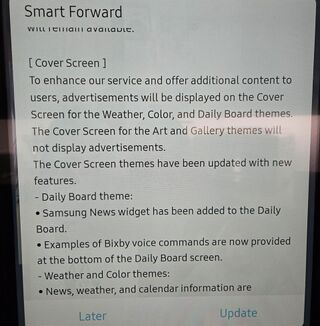Deceptive language frequently used against consumers
❗Article Status Notice: Inappropriate Tone/Word Usage
This article needs additional work to meet the wiki's Content Guidelines and be in line with our Mission Statement for comprehensive coverage of consumer protection issues. Specifically it uses wording throughout that is non-compliant with the Editorial guidelines of this wiki.
Learn more ▼
⚠️ Article status notice: This article has been marked as incomplete
This article needs additional work for its sourcing and verifiability to meet the wiki's Content Guidelines and be in line with our Mission Statement for comprehensive coverage of consumer protection issues.
This notice will be removed once sufficient documentation has been added to establish the systemic nature of these issues. Once you believe the article is ready to have its notice removed, please visit the Moderator's noticeboard, or the discord and post to the #appeals channel.
Learn more ▼
Deceptive language used by companies to impede the rights of consumers comes in many forms. Many of them can be boiled down to a few principles.
"For the safety of the consumer"
This is one of the most cited reasons to restrict what a consumer is allowed to do with their property. It is used to fight against right-to-repair legislation, restrict downloading of apps unless provided by Google or Apple, etc. Some notable incidents include:
Google comparing APK restrictions to airport security
For many years, one of the primary selling points of Android smartphones was that no big corporation could gatekeep what the user can run on their phones. But starting with Android 17 in 2026, only developers manually approved by Google can create APKs that install on Android.
Developers applying for approval are required to violate their privacy by disclosing their real-life identity to Google.
Google used false benevolence to excuse this restriction:
Google says you should think of the new requirements like checking IDs at the airport.
Storage access restrictions in Android
From source.android.com:
Third-party apps must go through the Storage Access Framework to interact with files on portable storage; direct access is explicitly blocked for privacy and security reasons.
The only "security" storage access framework actually gives the user is that it prevents them from granting access to the root directory of the external storage (not to be confused with "root access" which gives you superuser privileges).
Storage Access Framework is no replacement for legacy storage access given its slowness from its large processing overhead. The performance loss may be concealed to some extent from the fast hardware smartphones have nowadays, but even then, it increases battery usage.[2][3]
Non-replaceable batteries since the Samsung Galaxy S6
Justin Denison, Samsung's public relations person, said:
We refused to do this for some time. That's because we didn't want to have a built-in battery, until we were absolutely sure that users would feel confident about charging their phones.
OnePlus "encrypted" batteries
The OnePlus Pad has a serialized battery, meaning the device detects repairs not approved by OnePlus, which can result in functionality being disabled. This is an anti-repair practice first seen on Apple iPhone 11.
However, OnePlus marketed this practice as "encrypting" the battery. Given that people associate "encryption" with something positive (for example end-to-end encryption on a messaging service), OnePlus attempted to "recycle" this word to glorify an anti-repair practice.[5][6]
"Web Environment Integrity API" by Google
Google tried to implement Digital Restrictions Management (DRM) on the Internet, giving it the name "Web Environment Integrity API".[7][8]
"To enhance our services"
Samsung "offers additional content" by advertising on refrigerators
This is an update message shown on a Samsung refrigerator:

To enhance our service and offer additional content to users, advertisements will be displayed [...]
Despite using benevolent-seeming phrases such as "enhance our service" and " offer additional content", the actual aim of the change was to place large and obtrusive adverts in users' homes.
"To streamline the experience"
Fewer ports on modern laptops
In the 2000s and early 2010s, three or four USB ports built into laptops were not uncommon. Modern laptops in contrast usually feature one or two USB-A ports and might feature an USB-C port, in addition to less modular and less upgradeable parts. In reality, this has the opposite effect: due to fewer built-in ports on their laptops, the user is forced to carry hubs and adapters to be able to use the same functionality as before, which outweighs any portability benefit that the thinness might have afforded. Netbooks already existed as the category of laptops for people primarily interested in thinness.[9]
Google wants to help cleaning up MicroSD cards by denying normal write access
MicroSD cards became a major selling point of Android smartphones compared to iPhones, allowing the expansion of the storage capacity by multiple times at a time where smartphone internal storage capacities were only in the double-digit gigabytes. In addition, MicroSD cards make it easy to rescue data from a broken smartphone and to get immediate free storage within minutes without hour-long file transfers.
In Android 4.4 KitKat, Google revoked normal write access to the MicroSD card through applications installed by the user, with the exception of folders dedicated to each app at "Android/data/(package name)". The write access could not be restored through a setting in the menu, only through rooting.
Google's argument was to ensure no app can leave files behind after uninstallation:
The WRITE_EXTERNAL_STORAGE permission must only grant write access to the primary external storage on a device. Apps must not be allowed to write to secondary external storage devices, except in their package-specific directories as allowed by synthesized permissions. Restricting writes in this way ensures the system can clean up files when applications are uninstalled.
So they brought it back with Android 5.0, however only through Google's Storage Access Framework.
References
- ↑ Google will make sideloading apps way more difficult from next year - PhoneArena
- ↑ The Storage Access Framework is the only way for apps to work with all your files in Android Q. And it's terrible. - XDA developers
- ↑ Horrible access storage framework performance - androiddev - Reddit
- ↑ Samsung Galaxy Unpacked 2015 - Livestream (Replay (archive) at 27:37
- ↑ Oneplus' tablet uses an encrypted battery; how's that for repairability? - Louis Rossmann
- ↑ OnePlus takes on the iPad with the OnePlus Pad - Ars Technica
- ↑ Google's trying to DRM the internet, and we have to make sure they fail - Louis Rossmann (Brighteon mirror, BitChute mirror)
- ↑ Web Environment Integrity Must Be Stopped: Enslavement By "Remote Attestation" - Jody Bruchon
- ↑ Why are so many laptops having less ports?
